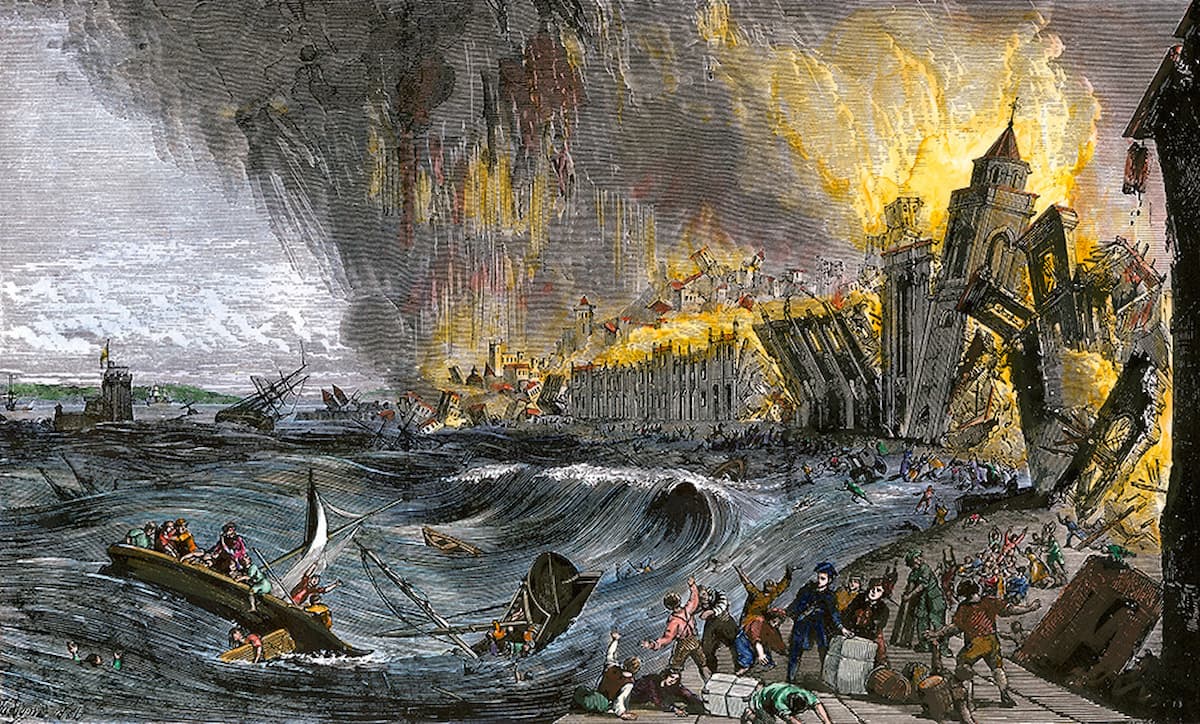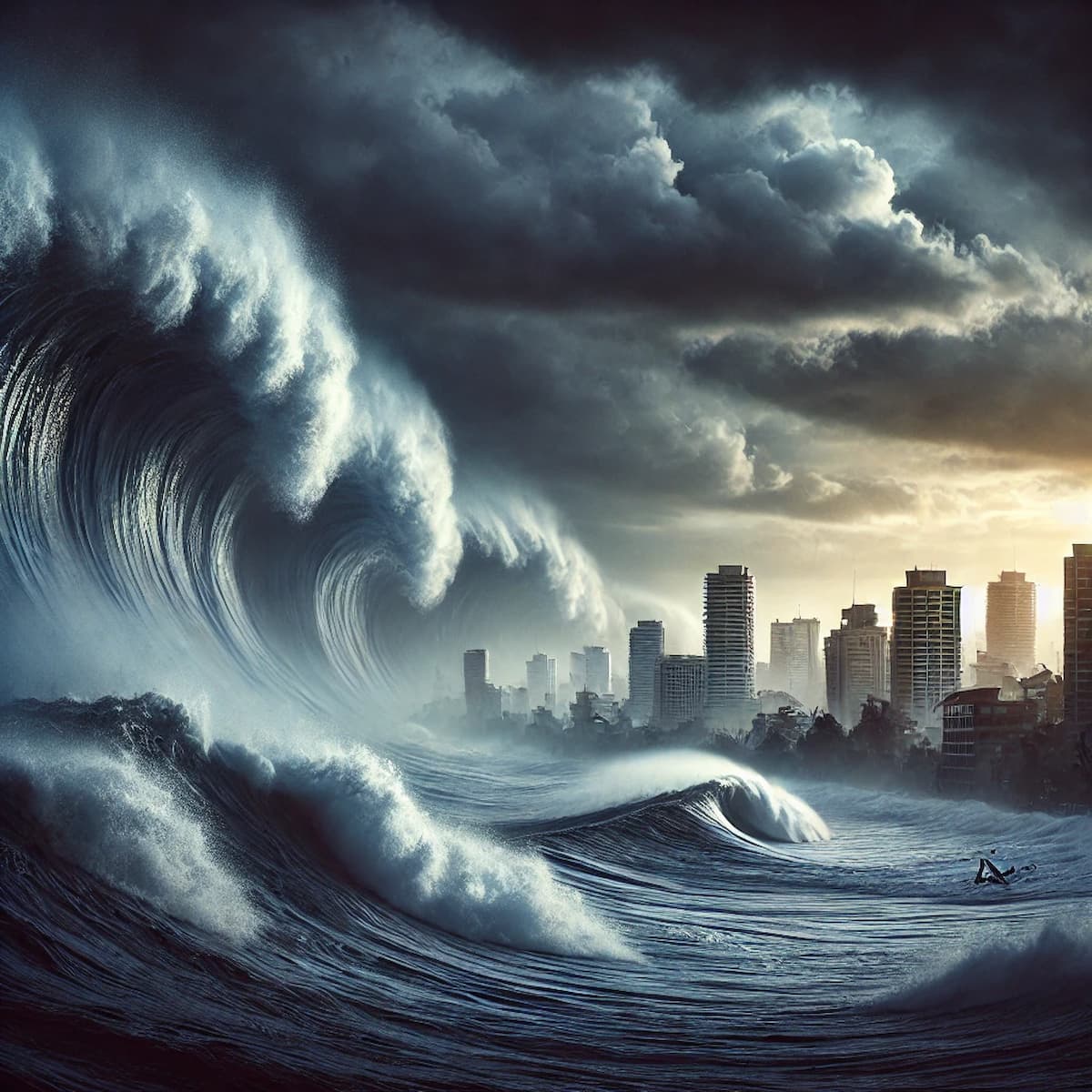
Watch short for this article (5 slides)
Scars on the Earth, Lessons for Humanity: Defining Natural Disasters That Shaped History
Human history is inextricably linked to the powerful and often unpredictable forces of the natural world. While gradual environmental changes shape civilizations over millennia, sudden, catastrophic natural disasters – earthquakes, volcanic eruptions, tsunamis, floods – have repeatedly delivered profound shocks, altering landscapes, decimating populations, toppling empires, and fundamentally redirecting the course of history. These events, often interpreted in their time through lenses of myth or divine will, serve as stark reminders of Earth's dynamic processes and humanity's enduring vulnerability. Examining some of history's most significant natural disasters reveals not only their devastating immediate impacts but also their lasting influence on science, society, and our approach to living on a restless planet.

Natural disasters have profoundly impacted civilizations throughout history.
The Shaanxi Earthquake (China, 1556): History's Deadliest Tremor
- The Event: On January 23, 1556, a catastrophic earthquake struck the Wei River Valley in Shaanxi Province, during the Ming Dynasty. While precise modern seismological measurements weren't available, estimates place its magnitude around 8.0 on the Richter scale. Its epicenter was near Huaxian.
- Mechanism and Impact: The earthquake occurred in a region characterized by loess plateaus – vast deposits of fine, wind-blown silt. The intense shaking caused the widespread collapse of structures and, crucially, triggered the failure of numerous yaodongs – traditional cave dwellings carved directly into the loess cliffs where much of the population lived. Massive landslides and ground liquefaction contributed significantly to the destruction. The affected area spanned hundreds of kilometers, impacting multiple provinces.
- The Unfathomable Toll: The Shaanxi earthquake holds the grim record for the deadliest earthquake in recorded history. Casualty estimates vary, but figures often cite around 830,000 deaths. The incredibly high death toll was a direct result of the combination of a powerful earthquake, extremely high population density, and vulnerable housing construction (the collapsing loess caves).
- Consequences and Lessons: The immediate aftermath saw immense social disruption and economic devastation. While scientific understanding of earthquakes was rudimentary, the event left an indelible mark on regional history and underscored the catastrophic potential when seismic hazards intersect with dense, vulnerable populations. It serves as a historical benchmark for earthquake lethality. (Source: Britannica - Shaanxi Earthquake)
The Tambora Eruption (Indonesia, 1815): Triggering the "Year Without a Summer"
- The Event: In April 1815, Mount Tambora, a stratovolcano on the island of Sumbawa (then part of the Dutch East Indies, now Indonesia), experienced the largest volcanic eruption in recorded human history, rated a VEI-7 (Volcanic Explosivity Index). The eruption column reached staggering heights, estimated at over 43 kilometers (27 miles), and the caldera collapse reduced the mountain's height by over a kilometer.
- Mechanism and Impact: The immediate effects were devastating locally: pyroclastic flows obliterated nearby settlements, and tsunamis struck surrounding islands, causing tens of thousands of deaths directly from the eruption. However, its most far-reaching impact was climatic. The eruption injected enormous quantities of sulfur dioxide (SO₂) high into the stratosphere. This SO₂ reacted with water vapor to form fine sulfate aerosols, creating a persistent stratospheric veil that reflected incoming sunlight back into space.
- Global Climate Chaos (1816 - "The Year Without a Summer"): This stratospheric aerosol layer caused significant global cooling, estimated at an average of 0.4–0.7 °C (0.7–1.3 °F), with much more dramatic regional effects. The subsequent year, 1816, became known as the "Year Without a Summer" in Europe and North America. It brought unseasonal cold, summer frosts and snowfalls, crop failures, widespread famine, food riots, and increased C epidemics (exacerbated by malnutrition).
- Consequences and Lessons: Tambora demonstrated the profound global reach of massive volcanic eruptions on climate and society. It led to mass migrations, economic disruption, and is even linked to cultural outputs like Mary Shelley's "Frankenstein" (written during that gloomy summer) and Lord Byron's poem "Darkness." It provided crucial early evidence for the link between volcanism and climate change. (Source: Smithsonian Institution Global Volcanism Program - Tambora; Source: NOAA Climate.gov - Year Without a Summer)
The San Francisco Earthquake and Fire (USA, 1906): Catalyst for Modern Seismology

The devastating fires following the 1906 San Francisco earthquake caused more destruction than the quake itself.
- The Event: On April 18, 1906, a major earthquake, now estimated at magnitude 7.9, struck the Northern California coast. The epicenter was near San Francisco. The rupture occurred along a significant portion (about 296 miles / 477 km) of the San Andreas Fault.
- Mechanism and Impact: Intense shaking caused widespread collapse of buildings, particularly unreinforced masonry structures. However, the earthquake's primary destructive legacy came from the subsequent fires. The shaking ruptured gas mains, igniting numerous blazes, while simultaneously breaking water mains, crippling the city's ability to fight the fires. The conflagrations raged for several days, consuming vast portions of the city.
- The Toll and Aftermath: Initial death toll reports were vastly underestimated (possibly for political/economic reasons); modern estimates suggest over 3,000 deaths and left hundreds of thousands homeless. Around 80% of the city was destroyed.
- Consequences and Lessons: The disaster was a watershed moment for earthquake science and engineering. Studying the ground displacement led geologist Harry Fielding Reid to formulate the elastic rebound theory, still fundamental to understanding how earthquakes occur. The catastrophe spurred the development and implementation of some of the world's first rigorous seismic building codes, emphasizing earthquake-resistant design. It also highlighted the critical importance of resilient infrastructure (water, gas lines) and organized emergency response in urban areas facing seismic risk. (Source: USGS - 1906 Earthquake Centennial)
The Central China Floods (China, 1931): A Hydrological Catastrophe
- The Event: During the summer of 1931, central China experienced arguably the deadliest series of floods in human history, impacting the basins of the Yangtze, Huai, and Yellow Rivers.
- Mechanism and Impact: The disaster resulted from a confluence of extreme weather factors: exceptionally heavy monsoon rains preceded by a severe winter with heavy snowmelt, combined with an unusually high number of intense cyclonic storms tracking inland. This overwhelmed river systems already prone to flooding due to centuries of deforestation and settlement on floodplains. Crucially, numerous dikes and levees, often poorly maintained, failed catastrophically under the immense pressure.
- The Scale of Devastation: The floods inundated an enormous area, estimated to be comparable in size to England or larger. Millions were left homeless. The death toll is highly uncertain due to the chaotic conditions and lack of reliable records, but estimates range widely, from official figures around 400,000 directly drowned to potentially up to 4 million when subsequent famine and disease (cholera, typhus) are included. Vast agricultural lands were submerged, leading to widespread starvation.
- Consequences and Lessons: The 1931 floods exposed the extreme vulnerability of the vast populations living along China's major rivers and the critical need for robust, well-maintained flood control infrastructure. The disaster contributed to the social and political instability plaguing China during that period and underscored the devastating potential of compound extreme weather events. (Source: Nature - Context on 1931 Floods - Example context source)
The Indian Ocean Earthquake and Tsunami (2004): A Wake-Up Call for Coastal Hazards

The 2004 tsunami devastated coastal communities across the Indian Ocean.
- The Event: On December 26, 2004, a massive undersea megathrust earthquake, with a magnitude estimated between 9.1 and 9.3, occurred off the west coast of northern Sumatra, Indonesia. It was one of the largest earthquakes ever recorded.
- Mechanism and Impact: The earthquake ruptured a huge segment of the fault boundary between the Indian Plate and the Burma Plate, causing significant vertical displacement of the seafloor over a vast area. This sudden displacement lifted an enormous volume of water, generating a series of powerful tsunami waves that propagated outwards across the entire Indian Ocean basin at speeds comparable to a jetliner in deep water.
- Widespread Devastation: The tsunami waves struck coastal regions in 14 countries with catastrophic force, often arriving with little or no warning. Indonesia (particularly Aceh province) was hit hardest and fastest, but devastating impacts were felt thousands of kilometers away in Sri Lanka, India, Thailand, Somalia, Maldives, and elsewhere. Wave heights varied but reached devastating levels (reportedly over 30 meters or 100 feet in some locations in Aceh).
- The Human Cost: The disaster claimed the lives of over 230,000 people and displaced millions, making it one of the deadliest natural disasters in modern history. The sheer geographic scale of the impact was unprecedented.
- Consequences and Lessons: The 2004 tsunami starkly highlighted the vulnerability of coastal populations and the critical absence of a tsunami warning system in the Indian Ocean (unlike the Pacific Tsunami Warning Center). This tragedy directly led to the establishment of the Indian Ocean Tsunami Warning and Mitigation System (IOTWMS) and spurred significant global investment in tsunami detection (seismic networks, DART buoys), modeling, and public education and preparedness efforts worldwide. (Source: NOAA Tsunami.gov - Context on warning systems)
Conclusion: Learning from Catastrophe
The historical record is punctuated by natural disasters that have irrevocably altered human societies and the physical environment. Events like the Shaanxi earthquake, the Tambora eruption, the San Francisco earthquake and fire, the China floods, and the Indian Ocean tsunami demonstrate the immense power inherent in Earth's geological and atmospheric systems. While causing unimaginable immediate suffering and destruction, these catastrophes have also served as powerful catalysts.
They have driven scientific inquiry, leading to fundamental breakthroughs in understanding earthquakes, volcanoes, climate dynamics, and hydrology. They have spurred engineering innovations, resulting in safer buildings, improved flood defenses, and resilient infrastructure. They have fostered societal change, prompting the development of early warning systems, international disaster relief cooperation, and land-use planning reforms. By studying these past events, acknowledging our vulnerabilities, and applying the hard-won lessons, we strive to build more resilient communities capable of better withstanding the inevitable natural hazards of the future.